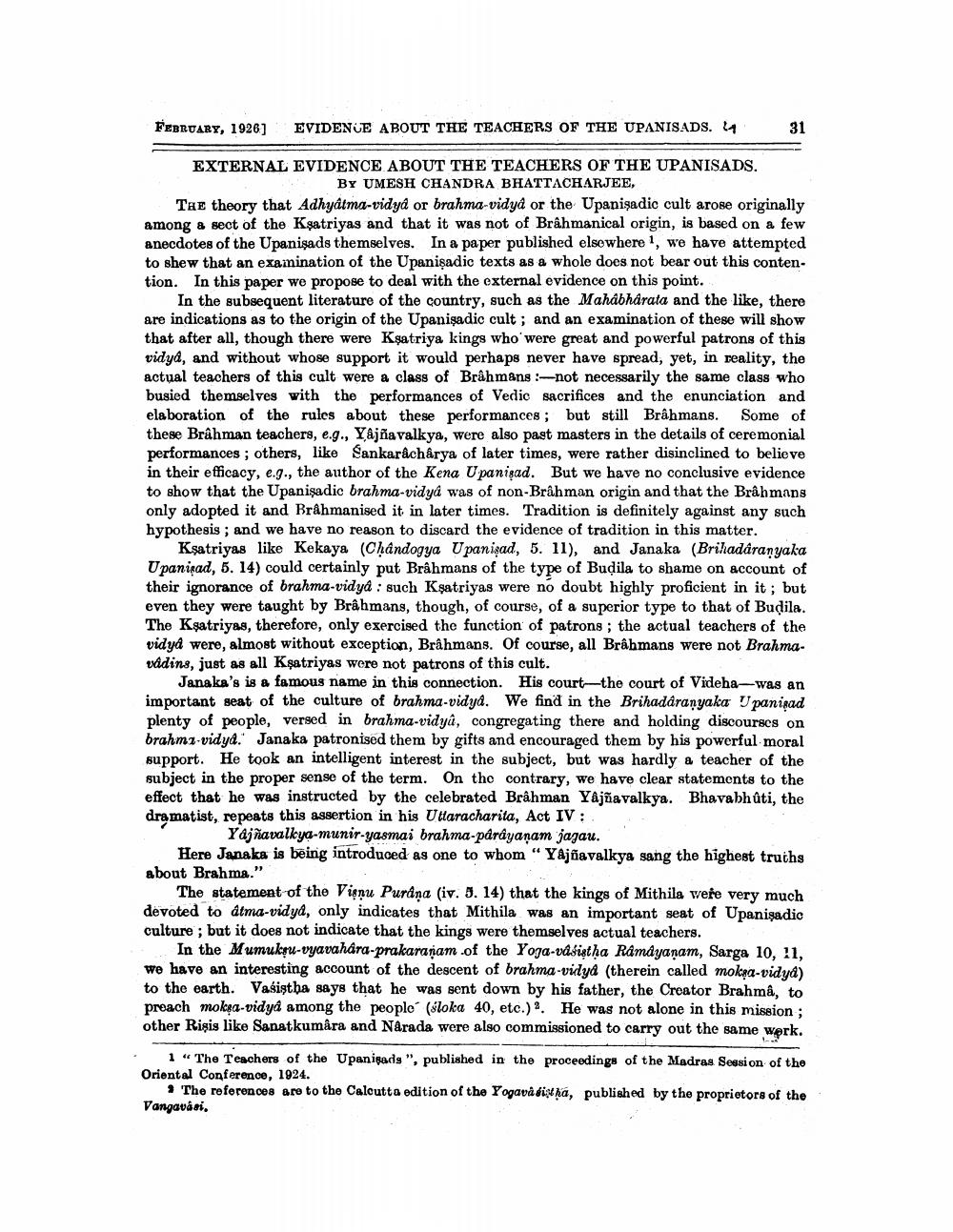________________
FEBRUARY, 1926]
EVIDENCE ABOUT THE TEACHERS OF THE UPANISADS.Ly
31
EXTERNAL EVIDENCE ABOUT THE TEACHERS OF THE UPANISADS.
BY UMESH CHANDRA BHATTACHARJEE, The theory that Adhyatma-vidyd or brahma-vidyd or the Upanigadic cult arose originally among a sect of the Ksatriyas and that it was not of Brâhmanical origin, is based on a few anecdotes of the Upanişads themselves. In a paper published elsewhere, we have attempted to shew that an examination of the Upanişadic texts as a whole does not bear out this contention. In this paper we propose to deal with the external evidence on this point.
In the subsequent literature of the country, such as the Mahabharata and the like, there are indications as to the origin of the Upanişadic cult; and an examination of these will show that after all, though there were Ksatriya kings who were great and powerful patrons of this vidya, and without whose support it would perhaps never have spread, yet, in reality, the actual teachers of this cult were a class of Brahmans -not necessarily the same class who busied themselves with the performances of Vedic sacrifices and the enunciation and elaboration of the rules about these performances; but still Brâhmans. Some of these Brâhman teachers, e.g., Yajnavalkya, were also past masters in the details of ceremonial performances; others, like Sankaracharya of later times, were rather disinclined to believe in their efficacy, e..., the author of the Kena U panigad. But we have no conclusive evidence to show that the Upanişadic brahma-vidyd was of non-Brahman origin and that the Bråhmans only adopted it and Brahmanised it in later times. Tradition is definitely against any such hypothesis ; and we have no reason to discard the evidence of tradition in this matter.
Ksatriyas like Kekaya (Chandogya Upanisad, 5. 11), and Janaka (Brihadaranyaka Upanigad, 5. 14) could certainly put Brâhmans of the type of Budila to shame on account of their ignorance of brahma-vidya : such Kşatriyas were no doubt highly proficient in it; but even they were taught by Brâhmans, though, of course, of a superior type to that of Budila. The Kşatriyas, therefore, only exercised the function of patrons; the actual teachers of the vidyd were, almost without exception, Brâhmans. Of course, all Brâhmans were not Brahmavadins, just as all Kşatriyas were not patrons of this cult.
Janaka's is a famous name in this connection. His court-the court of Videha-was an important seat of the culture of brahma-vidyd. We find in the Brihadaranyaka Upaniad plenty of people, versed in brahma-vidyû, congregating there and holding discourses on brahmi-vidyd. Janaka patronised them by gifts and encouraged them by his powerful moral support. He took an intelligent interest in the subject, but was hardly a teacher of the subject in the proper sense of the term. On the contrary, we have clear statements to the effect that he was instructed by the celebrated Brahman Yajžavalkya. Bhavabhûti, the dramatist, repeats this assertion in his Uttaracharita, Act IV:
Yajnavalkya-munir-yasmai brahma-pardyaņam jagau. Here Janaka is being introduced as one to whom “ Yajfavalkya sang the highest truths about Brahma."
The statement of the Vişnu Purana (iv. 5. 14) that the kings of Mithila were very much devoted to atma-vidyd, only indicates that Mithila was an important seat of Upanişadic culture ; but it does not indicate that the kings were themselves actual teachers.
In the Mumuksu-vyavahara-prakaranam .of the Yoga-vdsistha Ramayanam, Sarga 10, 11, We have an interesting account of the descent of brahma-vidyd (therein called mokra-vidya) to the earth. Vasistha says that he was sent down by his father, the Creator Brahma, to preach mokra-vidya among the peoplo (sloka 40, etc.). He was not alone in this mission; other Rişis like Sanatkumara and Narada were also commissioned to carry out the same work.
1 “The Teachers of the Upanigads ", published in the proceedings of the Madras Session of the Oriental Conference, 1924.
• The references are to the Calcutta edition of the Yogava fix ha, published by the proprietors of the Vangavaai,




